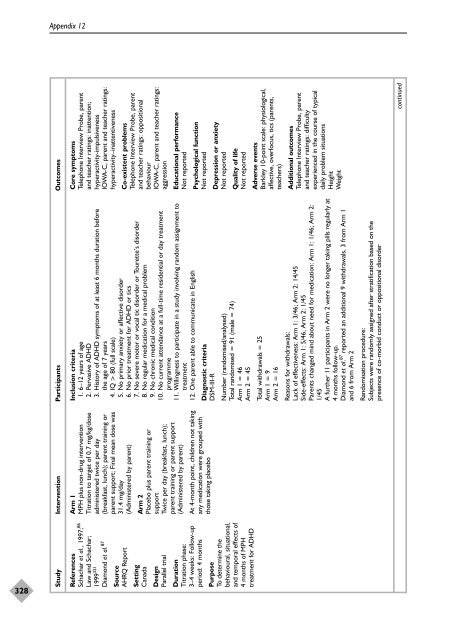APPENDICES. A systematic review and economic model of the ...
APPENDICES. A systematic review and economic model of the ...
APPENDICES. A systematic review and economic model of the ...
Create successful ePaper yourself
Turn your PDF publications into a flip-book with our unique Google optimized e-Paper software.
328<br />
Appendix 12<br />
Study Intervention Participants Outcomes<br />
Core symptoms<br />
Telephone Interview Probe, parent<br />
<strong>and</strong> teacher ratings: inattention;<br />
hyperactivity-impulsiveness<br />
IOWA-C, parent <strong>and</strong> teacher ratings:<br />
hyperactivity–inattentiveness<br />
Arm 1<br />
MPH plus non-drug intervention<br />
Titration to target <strong>of</strong> 0.7 mg/kg/dose<br />
administered twice per day<br />
(breakfast, lunch); parent training or<br />
parent support; Final mean dose was<br />
31.4 mg/day<br />
(Administered by parent)<br />
References<br />
Schachar et al., 1997; 86<br />
Law <strong>and</strong> Schachar;<br />
1999 321<br />
Diamond et al. 87<br />
Co-existent problems<br />
Telephone Interview Probe, parent<br />
<strong>and</strong> teacher ratings: oppositional<br />
behaviour<br />
IOWA-C, parent <strong>and</strong> teacher ratings:<br />
aggression<br />
Inclusion criteria<br />
1. 6–12 years <strong>of</strong> age<br />
2. Pervasive ADHD<br />
3. History <strong>of</strong> ADHD symptoms <strong>of</strong> at least 6 months duration before<br />
<strong>the</strong> age <strong>of</strong> 7 years<br />
4. IQ > 80 (full scale)<br />
5. No primary anxiety or affective disorder<br />
6. No prior treatment for ADHD or tics<br />
7. No severe motor or vocal tic disorder or Tourette’s disorder<br />
8. No regular medication for a medical problem<br />
9. No chronic medical condition<br />
10. No current attendance at a full-time residential or day treatment<br />
programme<br />
11. Willingness to participate in a study involving r<strong>and</strong>om assignment to<br />
treatment<br />
12. One parent able to communicate in English<br />
Source<br />
AHRQ Report<br />
Arm 2<br />
Placebo plus parent training or<br />
support<br />
Twice per day (breakfast, lunch);<br />
parent training or parent support<br />
(Administered by parent)<br />
Setting<br />
Canada<br />
Design<br />
Parallel trial<br />
Educational performance<br />
Not reported<br />
Psychological function<br />
Not reported<br />
At 4-month point, children not taking<br />
any medication were grouped with<br />
those taking placebo<br />
Duration<br />
Titration phase:<br />
3–4 weeks: Follow-up<br />
period: 4 months<br />
Depression or anxiety<br />
Not reported<br />
Quality <strong>of</strong> life<br />
Not reported<br />
Diagnostic criteria<br />
DSM-III-R<br />
Number (r<strong>and</strong>omised/analysed)<br />
Total r<strong>and</strong>omised = 91 (male = 74)<br />
Arm 1 = 46<br />
Arm 2 = 45<br />
Purpose<br />
To determine <strong>the</strong><br />
behavioural, situational,<br />
<strong>and</strong> temporal effects <strong>of</strong><br />
4 months <strong>of</strong> MPH<br />
treatment for ADHD<br />
Adverse events<br />
Barkley 10-point scale: physiological,<br />
affective, overfocus, tics (parents,<br />
teachers)<br />
Total withdrawals = 25<br />
Arm 1 = 9<br />
Arm 2 = 16<br />
Additional outcomes<br />
Telephone Interview Probe, parent<br />
<strong>and</strong> teacher ratings: difficulty<br />
experienced in <strong>the</strong> course <strong>of</strong> typical<br />
daily problem situations<br />
Height<br />
Weight<br />
Reasons for withdrawals:<br />
Lack <strong>of</strong> effectiveness: Arm 1: 3/46; Arm 2: 14/45<br />
Side-effects: Arm 1: 5/46, Arm 2: 1/45<br />
Parents changed mind about need for medication: Arm 1: 1/46; Arm 2:<br />
1/45<br />
A fur<strong>the</strong>r 11 participants in Arm 2 were no longer taking pills regularly at<br />
4 months follow-up.<br />
Diamond et al. 87 reported an additional 9 withdrawals, 3 from Arm 1<br />
<strong>and</strong> 6 from Arm 2<br />
R<strong>and</strong>omisation procedure:<br />
Subjects were r<strong>and</strong>omly assigned after stratification based on <strong>the</strong><br />
presence <strong>of</strong> co-morbid conduct or oppositional disorder<br />
continued
















